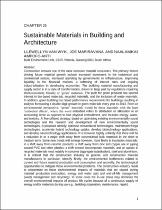JavaScript is disabled for your browser. Some features of this site may not work without it.
- ResearchSpace
- →
- Research Publications/Outputs
- →
- Book Chapters
- →
- View Item
| dc.contributor.author |
Van Wyk, Llewellyn V

|
|
| dc.contributor.author |
Mapiravana, Joseph

|
|
| dc.contributor.author |
Ampofo-Anti, N

|
|
| dc.date.accessioned | 2013-01-28T08:01:00Z | |
| dc.date.available | 2013-01-28T08:01:00Z | |
| dc.date.issued | 2012-01 | |
| dc.identifier.citation | Van Wyk, L, Mapiravana, J and Ampofo-Anti, N. 2012. Sustainable materials in building and architecture. Materials for a Sustainable Future. Royal Society of Chemistry. London, UK, pp. 668-697 | en_US |
| dc.identifier.isbn | 9781849734073 | |
| dc.identifier.uri | http://hdl.handle.net/10204/6442 | |
| dc.description | Copyright: RSC 2012. This is the postprint version of the work. The definitive version is published in Materials for a Sustainable Future, pp. 668-697 | en_US |
| dc.description.abstract | Most buildings up to the early nineteenth century, with the notable exception of prestigious public buildings, were constructed from easily available local materials. In the nineteenth century, developments in transport modes enabled the movement of heavy and bulky materials and opened up the era of prefabricated elements and product catalogues. At the same time, new materials were invented. Notwithstanding this, timber and timber-derived products, masonry units of clay and cement, concrete, steel, aluminium and glass remained and still remain the dominant materials used in construction. Recent developments in the twentieth century have included plastics in a number of forms, with the most recent material development including biocomposites for construction. Construction remains one of the most intensive material consumers: 40% of materials manufactured end up in buildings. Material demand is still dominated by the building sector, especially with respect to cement and fired clay. | en_US |
| dc.language.iso | en | en_US |
| dc.publisher | RSC | en_US |
| dc.relation.ispartofseries | Workflow;10078 | |
| dc.relation.ispartofseries | Workflow;9828 | |
| dc.subject | Sustainable building materials | en_US |
| dc.subject | Sustainable buildings | en_US |
| dc.title | Sustainable materials in building and architecture | en_US |
| dc.type | Book Chapter | en_US |
| dc.identifier.apacitation | Van Wyk, L. V., Mapiravana, J., & Ampofo-Anti, N. (2012). Sustainable materials in building and architecture., <i>Workflow;10078</i> RSC. http://hdl.handle.net/10204/6442 | en_ZA |
| dc.identifier.chicagocitation | Van Wyk, Llewellyn V, Joseph Mapiravana, and N Ampofo-Anti. "Sustainable materials in building and architecture" In <i>WORKFLOW;10078</i>, n.p.: RSC. 2012. http://hdl.handle.net/10204/6442. | en_ZA |
| dc.identifier.vancouvercitation | Van Wyk LV, Mapiravana J, Ampofo-Anti N. Sustainable materials in building and architecture.. Workflow;10078. [place unknown]: RSC; 2012. [cited yyyy month dd]. http://hdl.handle.net/10204/6442. | en_ZA |
| dc.identifier.ris | TY - Book Chapter AU - Van Wyk, Llewellyn V AU - Mapiravana, Joseph AU - Ampofo-Anti, N AB - Most buildings up to the early nineteenth century, with the notable exception of prestigious public buildings, were constructed from easily available local materials. In the nineteenth century, developments in transport modes enabled the movement of heavy and bulky materials and opened up the era of prefabricated elements and product catalogues. At the same time, new materials were invented. Notwithstanding this, timber and timber-derived products, masonry units of clay and cement, concrete, steel, aluminium and glass remained and still remain the dominant materials used in construction. Recent developments in the twentieth century have included plastics in a number of forms, with the most recent material development including biocomposites for construction. Construction remains one of the most intensive material consumers: 40% of materials manufactured end up in buildings. Material demand is still dominated by the building sector, especially with respect to cement and fired clay. DA - 2012-01 DB - ResearchSpace DP - CSIR KW - Sustainable building materials KW - Sustainable buildings LK - https://researchspace.csir.co.za PY - 2012 SM - 9781849734073 T1 - Sustainable materials in building and architecture TI - Sustainable materials in building and architecture UR - http://hdl.handle.net/10204/6442 ER - | en_ZA |






